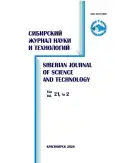Разработка и исследование эффективности алгоритма дифференциальной эволюции для решения задач многокритериальной оптимизации
- Авторы: Ерохин Д.А.1, Ахмедова Ш.А.1
-
Учреждения:
- Сибирский государственный университет науки и технологий имени академика М. Ф. Решетнева
- Выпуск: Том 21, № 2 (2020)
- Страницы: 134-143
- Раздел: Раздел 1. Информатика, вычислительная техника и управление
- Статья опубликована: 22.10.2023
- URL: https://journals.eco-vector.com/2712-8970/article/view/610999
- DOI: https://doi.org/10.31772/2587-6066-2019-20-2-134-143
- ID: 610999
Цитировать
Полный текст
Аннотация
В практической деятельности часто встречаются задачи, заключающиеся в поиске лучшего (оптимального) решения при наличии различных несводимых друг к другу и противоречивых (конфликтующих) критериев оптимальности, называемые задачами многокритериальной оптимизации. Один из наиболее распространенных методов решения подобного рода задач заключается в объединении всех критериев в один, используя некоторое линейное соотношение. Несмотря на простоту метода, при решении задач таким способом могут возникнуть проблемы с определением самого линейного соотношения, а именно весовых коэффициентов каждого критерия, неправильный подбор которых может привести к неоптимальным (в смысле теории Парето доминирования) решениям. В связи с этим в настоящее время предложены различные популяционные алгоритмы для решения описанных задач, которые в свою очередь являются модификациями этих же популяционных алгоритмов для решения задач однокритериальной оптимизации. В данной статье описаны разработанные модификации алгоритма дифференциальной эволюции (Differential Evolution, DE) для решения задач многокритериальной безусловной оптимизации на базе широко известных схем NSGA (Non-dominated Sorting Genetic Algorithm) и MOEA/D (Multiobjective Evolutionary Algorithm Based on Decomposition), использующих теорию Парето доминирования. Исследование эффективности алгоритма дифференциальной эволюции для решения задач многокритериальной оптимизации проводилось в зависимости от выбора оператора мутации исходного алгоритма дифференциальной эволюции и схемы учета множества целевых функций. Разработанные модификации были протестированы с помощью известных задач многокритериальной безусловной оптимизации вещественнозначных функций с 30 независимыми переменными, например, ZDT1, ZDT2, ZDT3 и т. д., также была решена практическая задача выбора эффективного варианта аппаратно-программного комплекса для систем управления космическими аппаратами. В результате экспериментов было установлено, что алгоритм дифференциальной эволюции демонстрирует лучшие результаты при использовании наиболее простых операторов мутации в сочетании со схемой учета целевых функций NSGA, таким образом, показана целесообразность его применения с данными параметрами для решения практических задач.
Ключевые слова
Об авторах
Данил Александрович Ерохин
Сибирский государственный университет науки и технологий имени академика М. Ф. Решетнева
Автор, ответственный за переписку.
Email: erohhaa@mail.ru
студент
Россия, 660037, г. Красноярск, просп. им. газ. «Красноярский рабочий», 31Шахназ Агасувар кызы Ахмедова
Сибирский государственный университет науки и технологий имени академика М. Ф. Решетнева
Email: shahnaz@inbox.ru
кандидат технических наук, доцент кафедры высшей математики
Россия, 660037, г. Красноярск, просп. им. газ. «Красноярский рабочий», 31Список литературы
- Choice of spacecraft control contour variant with self-configuring stochastic algorithms of multi-criteria optimization / M. Semenkina, Sh. Akhmedova, Ch. Brester [et al.] // Proceedings of the 13th International Conference on Informatics in Control, Automation and Robotics (ICINCO’2016). 2016. P. 281–286.
- Spacecraft solar arrays degradation forecasting with evolutionary designed ANN-based predictors / M. Semenkina, Sh. Akhmedova, E. Semenkin [et al.] // Proceedings of the 11th International Confer-ence on Informatics in Control, Automation and Robotics (ICINCO 2014). 2014. P. 421–428.
- Akhmedova Sh., Semenkin E. Co-operation of biol-ogy related algorithms for multiobective optimiza-tion problems // Proceedings of the International Conference on Computer Science and Artificial In-telligence (ICCSAI). 2014.
- Подиновский В., Ногин В. Парето-оптимальные решения многокритериальных задач. М. : Наука, 1982. 256 c.
- Storn R., Price K. Differential evolution – a simple and efficient heuristic for global optimization over continuous spaces // Journal of Global Optimiza-tion. 1997. Vol. 11, No. 4. P. 341–359.
- Zhang Q., Li H. MOEA/D: A multiobjective evolu-tionary algorithm based on decomposition // IEEE Transactions on Evolutionary Computation. 2007. Vol. 11, Iss. 6. P. 712–731.
- Srinivas N., Deb K. Multi-objective function opti-mization using nondominated sorting genetic algo-rithms // Evolutionary Computation. 1994. Vol. 2, No. 3. P. 221–248.
- Das S., Suganthan P.N. Differential evolution: A survey of the state-of-the-art // IEEE Transactions on Evolutionary Computation. 2011. Vol. 15, Iss. 1. P. 4–31.
- Deb K., Jain S. Running Performance metrics for evolutionary multi-objective optimization // Pro-ceedings of the 4th Asia-Pacific Conference on Simulated Evolution and Learning (SEAL’02). 2002. Vol. 1. P. 13–20.
- Zitzler E., Thiele L. An evolutionary algorithm for multiobjective optimization: The strength pareto approach // Technical Report 43, Computer Engi-neering and Networks Laboratory (TIK), Swiss Federal Institute of Technology (ETH) Zurich. 1998.
- Ah King R. T. F., Deb K., Rughooputh H.C.S. Com-parison of NSGA-II and SPEA2 on the multiobjec-tive environmental/economic dispatch problem // University of Mauritius Research Journal. 2010. Vol. 16. P. 485–511.
- Moore J., Chapman R. Application of particle swarm to multiobjective optimization // Technical Report, Department of Computer Science and Soft-ware Engineering, Auburn University. 1999.
- A fast and elitist multiobjective genetic algorithm: NSGA–II / K. Deb, A. Pratap, S. Agarwal [et al.] // IEEE Transactions on Evolutionary Computation. 2002. Vol. 6. P. 182–197.
- Zitzler E., Thiele L. Multiobjective evolutionary al-gorithms: A comparative case study and the strength Pareto approach // IEEE Transactions on Evolutionary Computation. 1999. Vol. 3, No. 4. P. 257–271.
- Knowles J. D., Corne D. W. The Pareto archived evolution strategy: A new baseline algorithm for Pareto multiobjective optimization // Proceedings of the IEEE Congress on Evolutionary Computa-tion. 1999. Vol. 1. P. 98–105.
- Semenkina M., Akhmedova Sh., Brester C., Semen-kin E. Choice of spacecraft control contour variant with self-configuring stochastic algorithms of mul-ti-criteria optimization // Proceedings of the 13th International Conference on Informatics in Control, Automation and Robotics. 2016. Vol. 1. P. 281–286.
Дополнительные файлы










